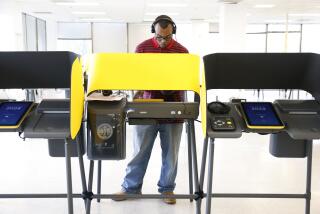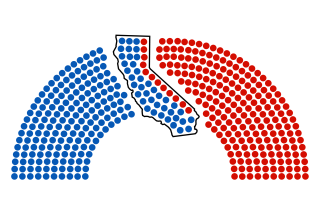Once the site of Bernie Sanders’ last stand, California now is pivotal to his 2020 prospects

Democratic presidential candidate Bernie Sanders campaigned in Los Angeles on Saturday.
Tim Johnson hasn’t stopped feeling the Bern.
A committed Bernie Sanders acolyte since 2016, Johnson was at a UCLA labor strike on Wednesday to watch the senator make his first California appearance as a 2020 presidential candidate. He’s taking part in Sanders rallies this weekend as well.
For the record:
5:45 p.m. March 23, 2019An earlier version of this story said that Rep. Barbara Lee (D-Oakland) was a high-profile Sanders backer in 2016. Lee did not endorse in the Democratic primary in 2016. Sanders campaigned for Lee in 2018.
“It’s like our wildest dream came true,” Johnson said of Sanders’ second presidential bid. “It’s actually happening.”
This time, however, both Johnson’s favorite candidate and his home state enjoy new prominence. Sanders is a Democratic front-runner, not an improbable insurgent. And California will not be the place of a symbolic last stand, as it was for Sanders before, but key territory to mine delegates and build momentum.
“It’s radically different,” said Ben Tulchin, Sanders’ San Francisco-based campaign pollster.
With its earlier primary on March 3 — and mail ballots going out a month prior — California is considered by the Sanders campaign to be among the crucial “first five,” lumping the Golden State in with traditional early nominating contests in Iowa, New Hampshire, South Carolina and Nevada.
By holding successive rallies this weekend in San Diego, Los Angeles and San Francisco, Sanders is signaling plans to mount an aggressive bid for California, capitalizing on his demonstrated fundraising prowess and cadre of devoted followers such as Johnson. A midday rally in downtown Los Angeles’ Grand Park had the feel of a laid-back family reunion, with attendees being greeted by a row of volunteers offering “high-fives for Bernie.”
How California’s early primary illustrates the state’s political inferiority complex »
Sanders also has the advantage of being the only candidate in the burgeoning Democratic field to have run a presidential campaign in California before, though one of his opponents, Sen. Kamala Harris, does have the benefit of having won three statewide races.
“There is no doubt he has a base here of some size that is highly committed to Bernie Sanders,” said Garry South, a veteran Democratic strategist based in Los Angeles. But, he cautioned, “I don’t think he can count on getting every single vote he got in 2016. He’s going to have to keep a fair proportion of those voters in the fold while reaching out to new voters.”
For many in the Sanders camp, the 2016 California primary outcome still stings. The democratic socialist and independent senator had engineered his long-shot bid into a protracted contest with Hillary Clinton and saw California’s June primary as an eleventh-hour attempt to claim momentum and persuade party insiders to side with him.
The delegate chase, which Sanders had trailed, came to an abrupt end the night before the vote, when the Associated Press said Clinton had won enough support to clinch the nomination.
The former secretary of State beat Sanders, 53% to 46%.
“By the time we reached California, we had greatly diminished resources,” said Jeff Weaver, Sanders’ 2016 campaign manager who is now a senior advisor to the senator. “We did not have the intensive statewide field effort I think you will see us launching.” Weaver predicted that this time “tens and tens of millions” will go toward television, radio and other paid media in the state.
Californians have been key to building up Sanders’ coffers; his campaign said nearly 110,000 donors from the state had given more than $2.6 million so far.
But the playing field is now substantially different. Sanders is up against a larger pool of candidates, many of whom have embraced the progressive themes of income inequality and economic injustice, as well as specific policies such as “Medicare for all,” that made Sanders a singular figure in 2016.
Bernie Sanders decries anti-Muslim violence in mosque visit and downtown L.A. rally »
Another challenge may be Democratic voters’ desire to elevate a new generation of leaders, which could cut against the 77-year-old senator. Candidates run the risk of feeling stale, South said, recalling that in 2004, then-Sen. Joe Lieberman failed to win support for his presidential bid from people who had avidly backed the Connecticut Democrat in 2000 as Al Gore’s vice presidential pick.
“Four years later, it was ‘time for a new face,’ ” said South, who worked on the Lieberman campaign.
MJ Sandhe, an animator from Los Angeles, still sounds wistful in recalling his work as a “super volunteer” for Sanders’ first run.
“We would wake up at 4 or 5 in the morning. I was getting the least amount of sleep ever,” said Sandhe, 30. “But it was so exciting.”
Sandhe is not sure whether he’ll back Sanders again. He’s intrigued by Andrew Yang, a venture capitalist whose campaign is centered on a “universal basic income” of $1,000 a month for every American adult. Sandhe fears Sanders is missing the chance to tinker with his message and expand his appeal.
“I’m just worried we’re going to be repeating the stump speeches we had in 2016,” Sandhe said.
MacKenzie Grow also voted for Sanders in 2016. The 24-year-old UCLA graduate student said she was waiting to hear more from the candidates about how they will confront racial inequality.
“I’m not blown away by anyone yet,” Grow said.
Sensitive to the perception that he appeals primarily to white male “Bernie Bros,” Sanders has made an effort to talk more about his biography, including his work in the civil rights movement and his family’s immigrant roots.
“One of the reason he’s telling his personal story about his family coming over from Poland after being persecuted is to apply more context and a different perspective,” Tulchin said, noting that Latino and Asian American immigrants could relate.
Perhaps the stiffest competition to Sanders in the state so far is from Harris, who launched her campaign in Oakland and has rolled out a steady stream of endorsements from her fellow California politicians. Among the most notable is Oakland Rep. Barbara Lee, whom Sanders campaigned for in 2018, who signed on early as a co-chair of Harris’ California campaign.
But true believers like Johnson, a 33-year-old financial consultant from Santa Ana, are certain the Golden State will be a sure thing for Sanders.
“I see all these other candidates splitting up their votes and Bernie being a landslide front-runner,” Johnson said. “I think the primary is going to be a walk in the park for him.”
More to Read
Get the L.A. Times Politics newsletter
Deeply reported insights into legislation, politics and policy from Sacramento, Washington and beyond. In your inbox three times per week.
You may occasionally receive promotional content from the Los Angeles Times.







